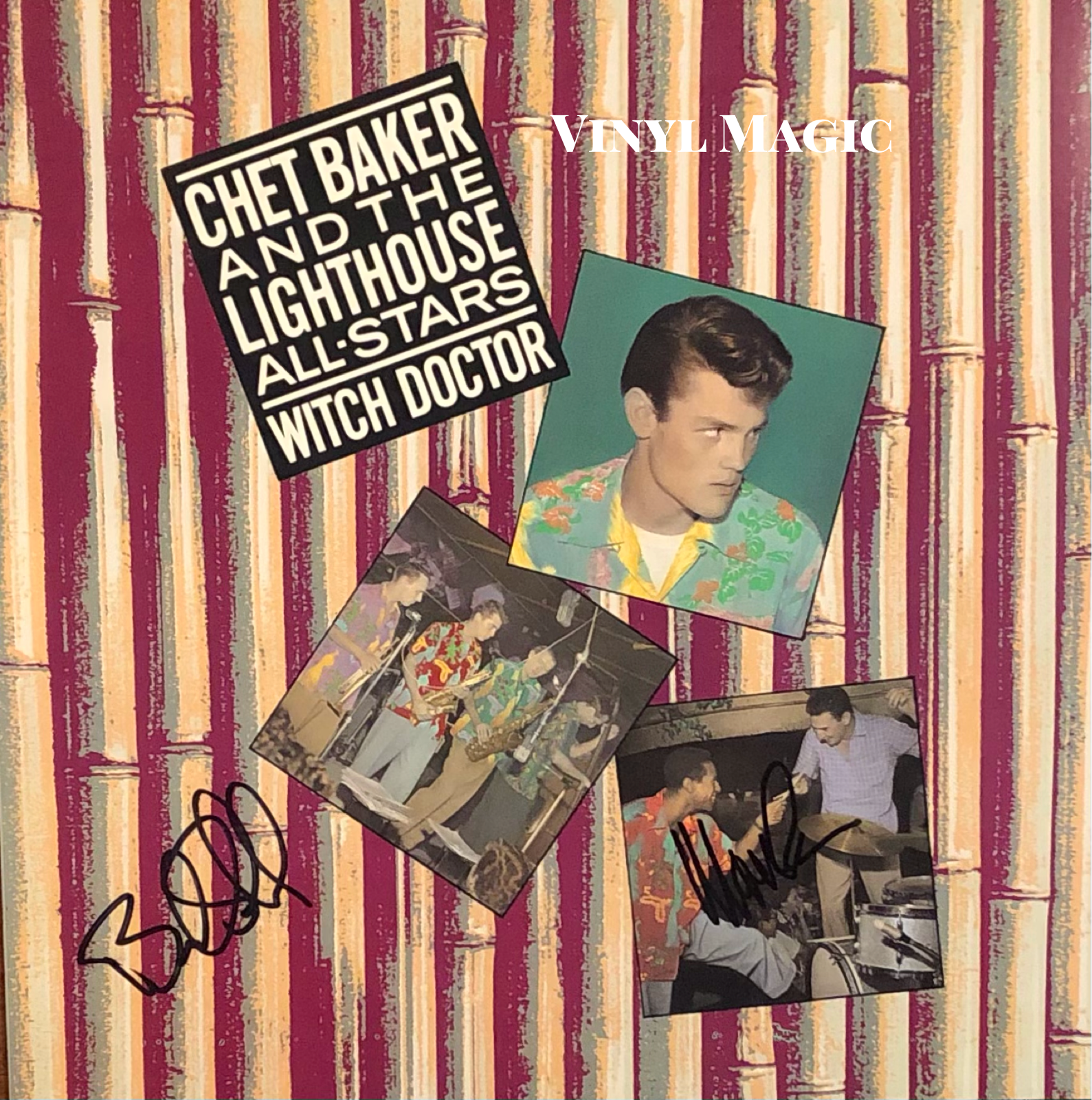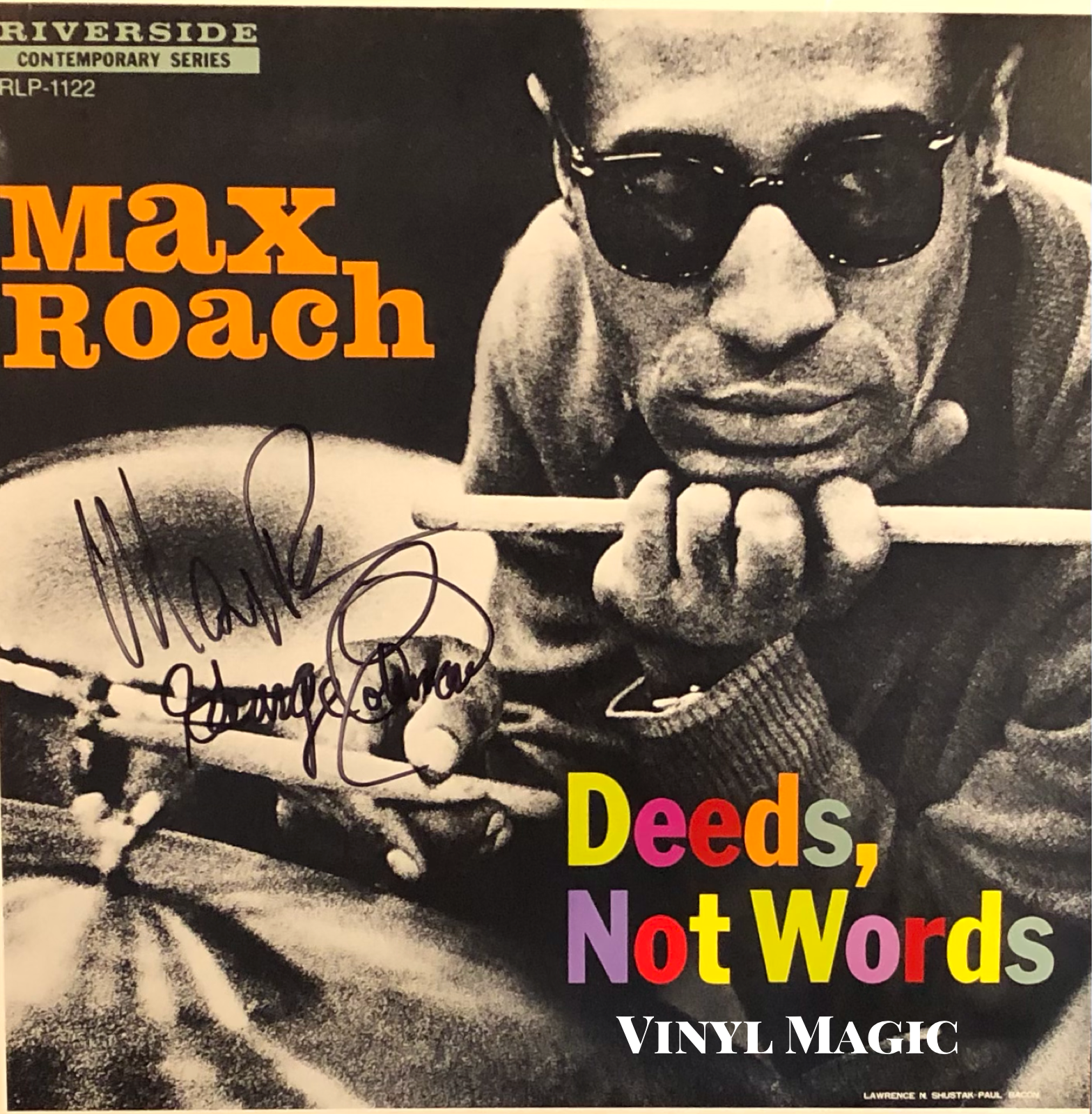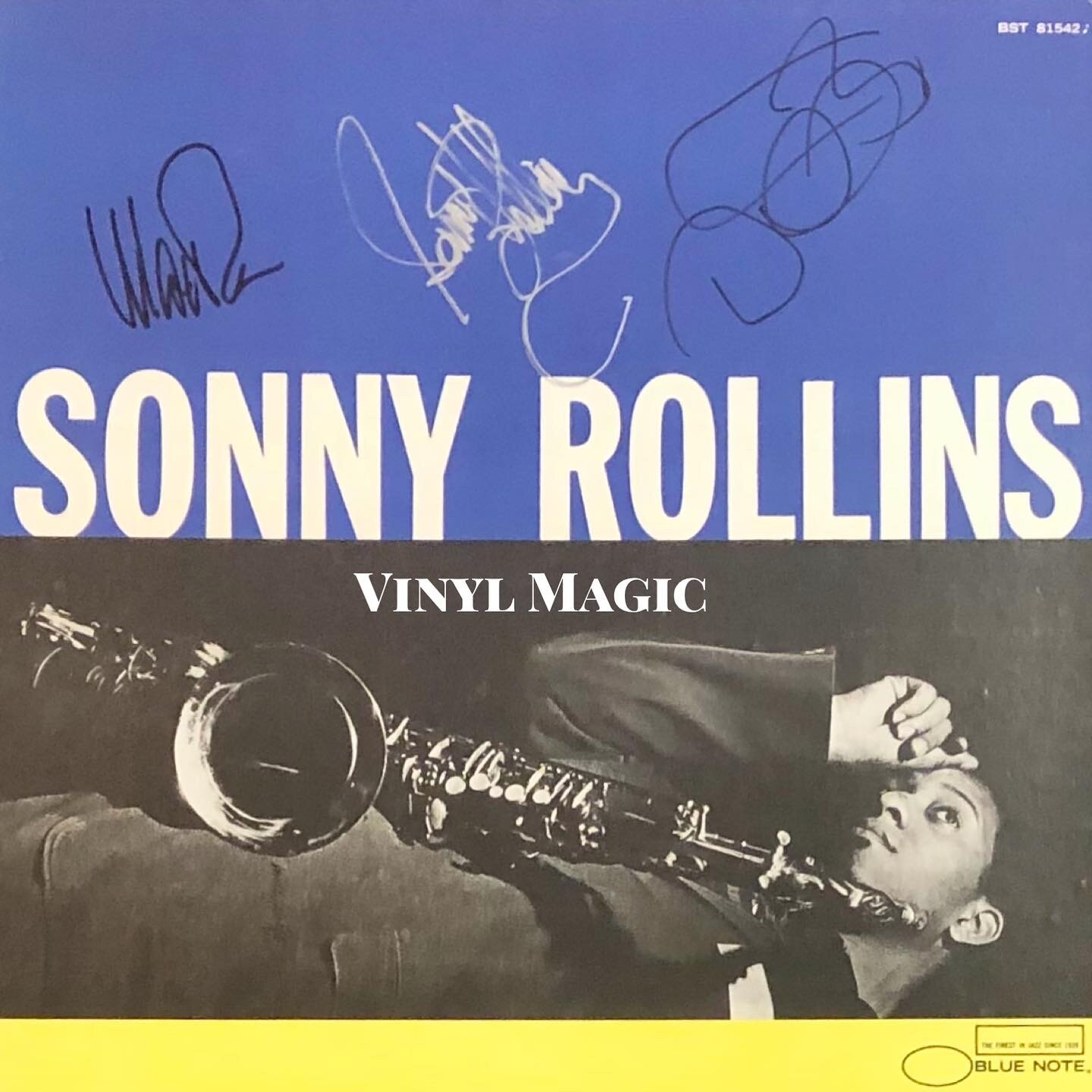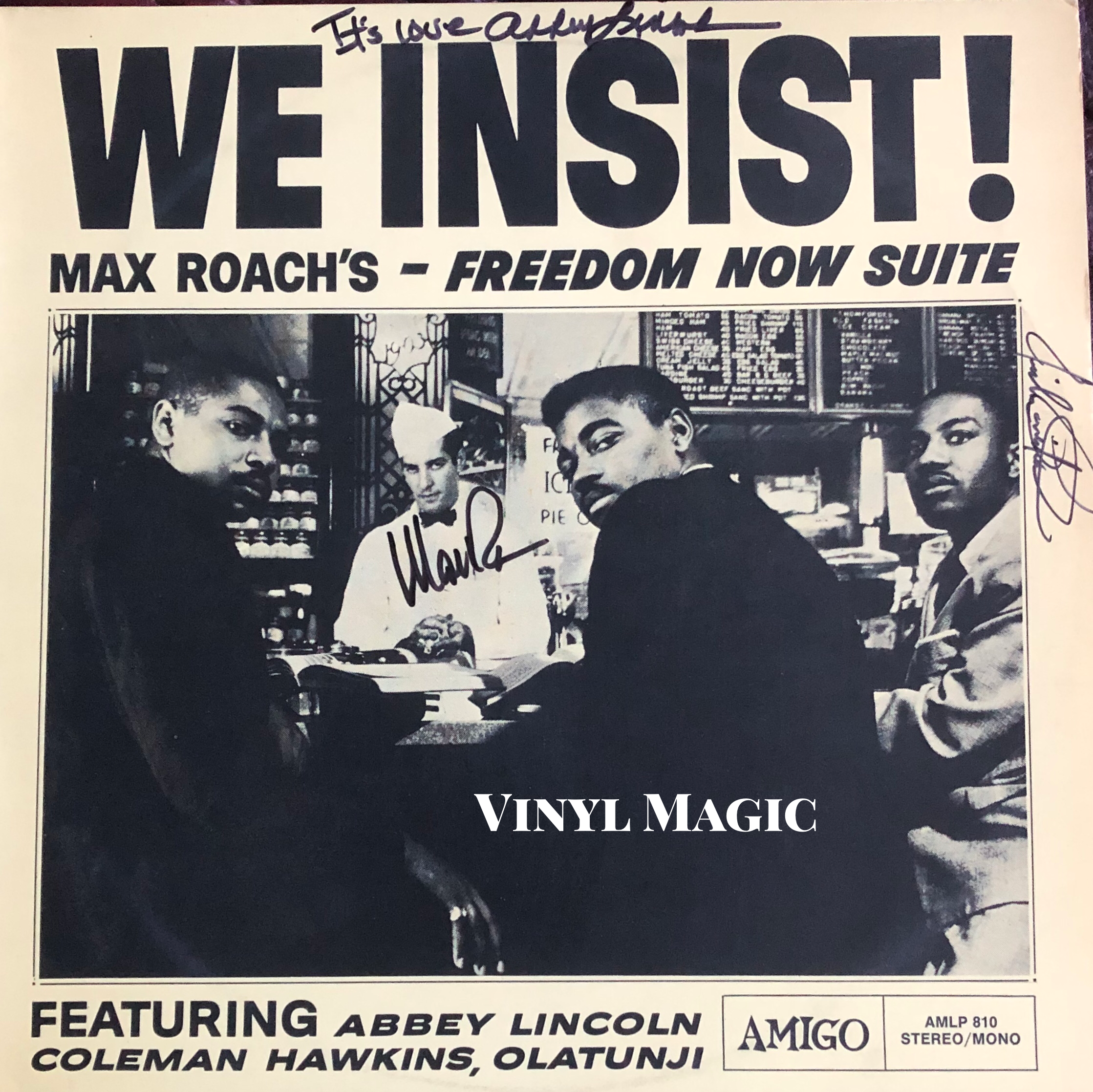Max Roach and Me…
One of the prime functions of the drums is to serve as an accompanying instrument. This can be developed by listening to everything around you and by fitting yourself in without being smothered or smothering others. It's difficult to do, due to the timbre of the instrument. You can't help smothering the horns unless you're very careful. And if you're too delicate, you can't say anything. You need proper balance and respect. It takes a great drummer to get a lot out of the instrument. Some guys have fabulous drum setups, but don't get anything out of it.
Max Roach - Downbeat 1958
Max Roach Quartet (1954) signed by Max
Rich versus Roach (1959) signed by Max, Julian Priester, Stanley Turrentine, Phil Woods
During an evening, week, or month of performing I play a host of drum solos. To live with myself, I have to constantly set up new things, and interest the members of the group. We all have to do this. The rule is not that you killed them last night--you know what will bring the audience to their feet. That's not the rule for the creative musician. You should try each night to introduce something that you didn't do the night before. It's always a challenge... to do something that wasn't done before. The public may not be aware of that, but for us it means we're developing ideas for new recordings, for new pieces.
Max Roach
Witch Doctor (1953 recordings, 1985 release) signed by Max, Bud Shank
Work Time (1956) signed by Max, Sonny Rollins, Ray Bryant
Jazz as a democratic form does not only mean “bebop,” but it goes back to its sources – Buddy Bolden, King Oliver and the like. It is people getting together and being so sympathetic to one another as they are sitting on the bandstand and playing music together in a way where they influence each other. It means to listen, to respect and to harmonize together. Jazz is not an imperialistic way, where a conductor tells that you are not doing it right. That is classical music. Jazz is fluid, and every generation has the opportunity of contributing something new.
Max Roach 1992
Diz and Getz (1955 recordings, 1977 release) signed by Max, Dizzy Gillespie, John Lewis, Ray Brown, Herb Ellis
Saxophone Colossus (1956) signed by Max, Sonny, Tommy Flanagan
When we did the historic concert with Charlie Parker, Bud Powell, Dizzy Gillespie, Mingus, and me at Massey Hall in Toronto, Mingus was the one who brought the engineer and tapes up there. Mingus and I put together a (record) company called Debut, and brought the engineer up, but we had to do it silently. Bird was signed with Norman Granz. The first record we put out on our label we couldn’t use Charlie Parker’s name on it. We called him Charlie Chan. Later on, we made deals with other people and it was released another way. You have to create your own opportunities, really.
Max Roach on forming a record company with Charles Mingus in 1952
Deeds, Not Words (1958) signed by Max, George Coleman
Jazz In 3/4 Time (1957) signed by Max, Ray Bryant
Also, the whole dogmatic attitude of "Jazz is only this", Max didn't think like that. Max was always looking ahead. He knew that jazz was in constant motion. One thing I like to say to all my students is "It's great to pay homage to the past, just don't get stuck in it." To me, Max shouldn't be remembered only as a great technical drummer or a bebop drummer...he was so much more than that. His compositions and odd meter explorations, plus his duos with Cecil Taylor, he was always on the cutting edge of where jazz should be going. And not only musically, but socially and politically as well. Those things aren't separable. Music always reflects the times and he knew that.
drummer Paul Wertico on his hero
Max (1958) signed by Max
Sonny Rollins (1957) signed by Sonny, Max, Donald Byrd
Max Roach, drummer, percussionist, band leader, composer, arranger, civil rights activist...a man of innumerable talents. Born in North Carolina, raised in Brooklyn, Max Roach made his professional debut with Duke Ellington as an eighteen year old, straight outta high school. As Max recalled, "Most of the great drummers were in the Army (in 1942), so when (Ellington drummer) Sonny Greer got sick...I got the job because I could read music. From that time on, everyone began calling me to make records... Whether I could play or not, they thought I could play because I'd been with the master."
Max made his recording debut with Coleman Hawkins a year later, and the history of jazz drumming was forever altered. Max and Kenny Clarke became the drummers of choice for bebop as it was emerging in the 1940s, a harmonically challenging music with rapid chord changes which was being introduced and mastered by Charlie Parker and Dizzy Gillespie. Essentially, the brilliance of bebop was to double the beats from four to eight in a single measure, and it took considerable and prodigious skill to make it look and sound seamless. "Woody 'n' You", a 1943 Dizzy Gillespie composition, is generally acknowledged by musicologists to be the first bebop record. Alongside a stalwart front line horn section that includes Coleman Hawkins, Don Byas, Budd Johnson and Dizzy Gillespie, Max Roach is the drummer who supplies dexterous fills, dazzling rim shots and shimmering cymbals. And his fellow drummers took notice. As an awestruck Stan Levey observed, "I came to realize that, because of him, drumming no longer was just time, it was music."
Rollins Plays For Bird (1957) signed by Sonny Rollins, Max
Max Roach 4 Plays Charlie Parker (1959) signed by Max, George Coleman
Soon, Max began working with Charlie Parker and recorded "Billie's Bounce", "Ko Ko", "Parker's Mood", and "Now's The Time', all important Parker compositions in the bebop canon. Max described the luminous luster of Charlie Parker, "Bird was kind of like the sun, giving off the energy we drew from him. We're still drawing on it. His glass was overflowing in any musical situation, his ideas just bounded out and this inspired anyone who was around. He had a way of playing that affected every instrument on the band stand." However, Parker's drug addiction spiraled out of control and, for a time, Max struggled similarly. While Parker succumbed to his demons in 1955, Max was able to overcome his afflictions and kick heroin, and went on to a storied jazz career.
As a leader, Max released more than seventy-five albums and he was a sideman on hundreds of other sessions, including some of the most celebrated recordings in jazz history with Dizzy Gillespie, Charlie Parker, Miles Davis, Thelonious Monk, and Sonny Rollins. Max also formed a quintet which he co-led with Clifford Brown, a gifted trumpeter and composer, which featured Harold Land, George Morrow, Richie Powell and Sonny Rollins. In 1956, Clifford Brown died tragically in a car accident when he was only twenty-five but the Roach-Brown Quintet left behind an influential trove of hard bop recordings.
Study In Brown (1955) signed by Harold Land, Max “Thanks Brownie”
Max recalled, "We had a date in Chicago, but Clifford was in Philadelphia playing at one of these Sunday afternoon concerts they held there. On the phone, he told me he would be going through Elkhart, Indiana on the way to endorse a line of trumpets. He was to leave around two that morning, get there by nine and then arrive in Chicago later that day. That actually was the first time we had not travelled together as a band. The next morning, Joe Glaser [the band’s manager] phoned me up and told me to brace myself: Clifford was killed that night in an automobile accident on the Pennsylvania Turnpike as well as Richie Powell – pianist of the quintet and Bud’s brother – and his wife, too. They were 25, 23 and 21 years old. But in the same breath, Glaser told me that both Miles (Davis) and Roy Eldridge happened to be in town and I could still make the date! I just couldn’t believe it: This is my agent telling me that!" It was a devastating loss which took years to absorb, but Max soldiered on.
At Basin Street (1956) signed by Max, Sonny Rollins
In 1960, the Junior League Of the NAACP commissioned Max to write a jazz suite for the upcoming centennial of the Emancipation Proclamation. Max collaborated with Oscar Brown Jr., an actor, lyricist, writer and together, they wrote the potent We Insist! Freedom Now Suite. The opening track is "Driva Man,” which Nat Hentoff describes in the liner notes as "a personification of the white overseer in slavery times who often forced women under his jurisdiction into sexual relations. Many overseers were relentlessly brutal." Max simulates the crack of a whip with precise rim shots and tambourine shakes while Abbey Lincoln (later Max's wife for almost ten years) delivers a harrowing and soulful vocal. Coleman Hawkins plays a gritty, baleful tenor saxophone and a squeak is heard in what was thought to be the best take. After listening to this take, Coleman said, "No, don't splice. When it's all perfect, especially in a piece like this, there's something very wrong." The closing track, "Tears For Johannesburg", was written in response to the Sharpeville Massacre which occurred on March 21, 1960 (a current South African National holiday in support of human rights). It starts with bluesy, expressive vocalese by Abbey Lincoln and then the horn section - Booker Little on trumpet, Walter Benton on tenor saxophone, Julian Priester on trombone - all take mournful solos while Max, Ray Mantilla and Michael Olatunji lay out funky drum and conga support. It is a powerful and compelling suite of music, perfect in its imperfections, especially in the hands of these skilled jazz masters.
We Insist! Freedom Now Suite (1960) signed by Max, Abbey Lincoln, Julian Priester
When the album was released, it was controversial and some critics panned it. However, it did sell. As Max disclosed, "So we recorded it and then sneaked it into South Africa as a jazz record. But then it got banned because of Nat (Hentoff)’s liner notes, which explained that one of the pieces was about the massacre of people in Johannesburg. Then it reached the Associated Press that a jazz record had been banned in South Africa. That record became a collector’s item and sold more copies than any record I’ve ever made." Max was nonplussed about the critical reaction as he determined that he would continue to make challenging music. The trifles and romps of Cole Porter, George Gershwin and other denizens of Tin Pan Alley were abandoned, Max had thornier issues to pursue and explore.
The first time I met Max Roach, he was at a Tower Records store signing in 1992. There was no performance, just Max sitting at a counter signing his latest CD, To The Max! He was tall, lean, impeccably dressed and he smiled warmly when he saw some of the vinyl I had brought. He especially liked Rich versus Roach, a drum battle with his friend Buddy Rich. "That was a fun album to make," he said as he inscribed it, "Thanks Buddy." Luckily, I saw Max perform several times thereafter with his Double Quartet at the Blue Note in New York City and the shows were always interesting. As Max once said, "Even though I'm involved with music for the sake of entertainment, I always hope to offer some kind of enlightenment."
Rich versus Roach (1959) signed by Max, “Thanks Buddy”
Easy Winners (1985) signed by Max, Maxine Roach, Cecil Bridgewater, Tyrone Browne, Odean Pope
The Double Quartet featured his piano-less quartet - Odean Pope on tenor saxophone, Cecil Bridgewater on trumpet, Tyrone Brown on bass - with a string quartet: two violins, cello and his daughter Maxine on viola. Before each show, Max would appear at the front of the stage with his hi-hat (two mated cymbals on a tripod stand with a foot pedal) and a pair of drum sticks. He would begin an extended drum solo using the top cymbal, bottom cymbal and rod. He called this performance "Mr. Hi-Hat" and it was mesmerizing, a master class by a master percussionist. The rest of the band members then joined and highlights of the set included "A Little Booker", a song Max wrote as a tribute to Booker Little, "Hi Fly", a Randy Weston penned jazz standard, and "Sis", an Odean Pope elegiac ballad with a beautiful string quartet introduction. After each show, I would visit with Max in his dressing room and he was kind and generous. Immaculately turned in a bespoke suit, he seemed urbane and elegant, looking every bit the professor that he was at the University of Massachusetts for almost twenty-five years.. Max loved looking at my vinyl, and he was quiet and reflective when he signed Study In Brown with "Thanks Brownie".
Max Roach probably summed up his entire philosophy and approach with this remembrance:
"There was one unforgettable night when I worked with Pres (tenor saxophonist Lester Young) at Birdland. Because I was with Pres, and because he and (drummer) Papa Jo Jones were so close in the (Count) Basie band, I played all of Papa Jo's old licks. At the end of the evening, after I said good night to Pres, he gave me one of those succinct lessons in that personal language of his. He said, 'You can't join the throng until you write your own song.' That's a great lesson, something that stays with you the rest of your life. This music allows you, prefers you to be an individual, to do your own thing."
Thanks Max for the entertainment. the enlightenment, and all those wonderful songs.
You will always remain way above the throng.
Speak, Brother, Speak! (1963) signed by Max
Max Roach +4 (1956) signed by Max, George Coleman, Bob Cranshaw
Max Roach +4 & More (1956) signed by Max
M’Boom (1979) signed by Max, Joe Chambers
Choice Max Roach Cuts (per BK's request)
https://www.youtube.com/watch?v=FHbqzX1zokk
"Mr. Hi-Hat" Max Roach 1994 solo
https://www.youtube.com/watch?v=IF6q6XKKrik
"Love For Sale > Driva Man" Live 1964 with Abbey Lincoln and Clifford Jordan
https://www.youtube.com/watch?v=3XA_Jugejto
"Confirmation" 1953 with Charlie Parker, Max Roach
https://www.youtube.com/watch?v=MsMCLjztaOc
"Blue 7" Saxophone Colossus 1956 with Sonny Rollins, Tommy Flangan, Max Roach
https://www.youtube.com/watch?v=8wGJpbPKbz8
"Ko Ko" 1945 with Charlie Parker, Dizzy Gillespie, Max Roach
https://www.youtube.com/watch?v=UXPzAasKWQg
Cherokee" Study In Brown 1955 Clifford Brown-Max Roach Quintet
https://www.youtube.com/watch?v=mNSXSR0ebxM
"The Blues Walk" More Study In Brown 1955 Clifford Brown-Max Roach Quintet
https://www.youtube.com/watch?v=11oIOUhpeVs
"Rumble In The Jungle" 1979 M'Boom with Max Roach, Joe Chambers, Ray Mantilla




















